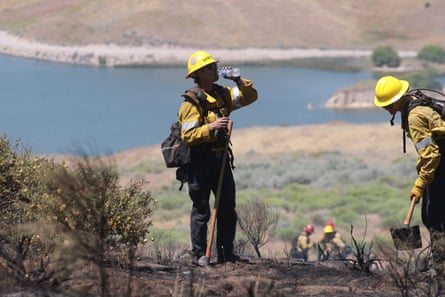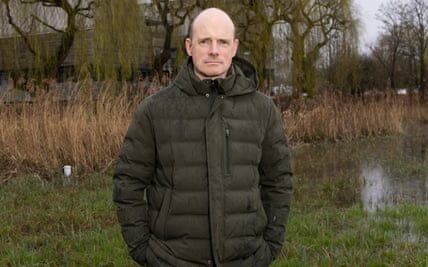With the official start of summer still weeks away, a record-setting heatwave is cooking the south-western US, causing dangerous conditions far earlier than normal.
More than 34 million people were under heat alerts on Thursday afternoon, as warnings were issued from the southern tip of Texas across Arizona and Nevada, and up through the center of California to the northern part of the state.
The brutal conditions are expected to linger through Friday, according to the National Weather Service, as communities across the region brace for days of potentially life-threatening temperatures. Parts of California, the Great Basin and the south-west are forecast to break daily-high temperature records on Thursday and Friday, as Las Vegas, Nevada, and Phoenix, Arizona, hit 110F for the first time this year.
Experts have warned this could be just the start of another record-smashing season with the potential to usurp 2023 as the world’s hottest year. A three-month outlook on seasonal temperatures published by the National Oceanic and Atmospheric Administration (Noaa) in mid-May forecasts above-average temperatures for most of the country through the summer.
By Thursday afternoon, the dangerous conditions had already set new daily records, including a record high in Bishop, California, which registered at 102F on Wednesday. Las Vegas tied its record for earliest 110F day Thursday afternoon, with many more hours of heating to go.
“Widespread high and low temperature records being tied or broken between California Nevada and Arizona today will expand a bit northward into Oregon and Washington on Friday and Saturday,” the NWS said in a forecast issued Thursday, warning that high overnight temperatures will intensify risks for those without access to cooling.
Such early season extremes put even more strain on the systems and vulnerable communities bearing the brunt of rising temperatures, as the human-caused climate crisis pushes already-sweltering locales past the brink.
Researchers are starting to see the impact of heat in sharper focus, finding connections to a range of issues, from pregnancy complications to school performance. “Chronic heat exposure can affect people in really pernicious and hidden ways,” said Dr V Kelly Turner, an associate professor of urban planning and geography at the University of California at Los Angeles who researches heat equity and policy.
“There are all these points where heat touches your life and it doesn’t even have to be that extreme,” Turner explained. As temperatures rise, more people are forced to live on a precipice where slight upticks turn dangerous quickly, she added: “There are a lot of people who are chronically too hot. An extreme heat event can shift the balance.”

The sharp shifts in temperature during the shoulder seasons can also be incredibly dangerous, as can long stretches of time spent in hot conditions. These sudden changes can come before communities are prepared. “Earlier in the year, people haven’t had a chance for their bodies to become acclimated to hotter temperatures,” Turner said. “The change in heat conditions might be just as critical as the extreme head-turning temperatures.”
Officials have also warned of yet another danger lurking in rivers and lakes, when they fill with runoff from snow melting in California’s mountain ranges, making them more hazardous.
Las Vegas, Nevada, and Phoenix, Arizona, are expected to breach 110F for the first time this year on Thursday, and Death Valley could reach 125F – the earliest that level of heat has been recorded in history.
Even after the sun sets, there will be little relief, as experts expect this heatwave to break night-time records in some places, adding risks for people and animals alike.
The heatwave hit Mexico first, killing at least 48 people, according to that country’s health ministry. Conditions got so hot in some areas, monkeys were falling dead from the trees.
‘The silent killer’
Heat is the most deadly weather-related disaster in the US, outpacing the number of people killed by hurricanes by eight to one, and the toll is sharply rising. Last year, more than 600 people died in the metro area of Phoenix, surging by 50% and breaking a grim record that had only been set in 2022. Often called a “silent killer”, heat causes deaths that are hard to track. Experts believe the numbers of those affected by these events to be far higher.
Though Phoenix is one of the country’s hottest cities, it is considered a leader in heat adaptation. Arizona named the first statewide chief heat officer last year, and both the state and the city have made the issue a priority. It’s still been difficult to keep up. Maricopa county, where Phoenix is located, is already grappling with 52 deaths potentially linked to heat, and summer has just begun.
Heatwaves are not only becoming hotter, they are lasting longer and affecting larger areas. Atmospheric pressure plays a role, causing so-called “heat domes” – which trap heat similar to putting a lid on a pot of boiling water – and global patterns like El Niño can influence weather to trend hotter in some places. All the while, the climate crisis is turning up the dial.
“Not only was 2023 the warmest year in Noaa’s 174-year climate record, it was the warmest by far,” said the Noaa chief scientist, Dr Sarah Kapnick, who called the findings “astounding”. Now, 2024 has a one in three shot at beating that record. Scientists with Noaa report that this year will almost certainly rank in the top five hottest in history.

While risks posed by a warming world are rising for all, the impacts felt from heat on day-to-day lives can vary greatly.
In Chico, a small city in northern California’s Sacramento valley, temperatures had climbed to 104F by early Wednesday afternoon. But in a region that has grown used to sweltering summer temperatures, some residents appeared unfazed.
Many flocked to the city’s Bidwell park to escape the heat. The park was busy on Wednesday afternoon with kids swimming in Sycamore Pool, which is filled with water dammed from Big Chico Creek, while under a canopy of trees dozens of people sat on picnic blankets and lawn chairs and a group gathered in a circle playing music.
“This is not that bad to me,” said Stephan Jones, as he sat in the shade with his toy chihuahua, Luna. “I didn’t even have to get into the water.”
The area always feels fresh, said Bobbie Rae Jones (no relation to Stephan Jones), who came to the park with her teenage son. “I’ve been coming here for years with my kids. With the grass and the trees, it’s always cooler here,” she said. The trees are a welcome change from her home in nearby Paradise, where 2018’s devastating fire wiped out the town and much of the area’s beloved trees.
“Living in Paradise with the trees gone, it’s this penetrating heat,” she said.
While many northern California residents are accustomed to the high temperatures, the heat poses a major risk to those living outdoors. There are relatively few places people can go to cool off, said Lauren Kennedy, the program coordinator of Safe Space, a non-profit that operates shelters during extreme weather in Chico.
Safe Space provides cooling-center operations for the city during hot conditions, Kennedy said, but that is dependent on whether it has a space it can use. The non-profit works with churches and other groups to provide temporary shelter, but doesn’t have any spaces available this week.
Instead, the organization is performing street outreach and distributing cold water, Gatorade, fruit cups, cooling packs and ice bags to unhoused people living on the streets.
“We will be more aggressively going out to camps around town and getting those life-saving supplies out,” Kennedy said. “Getting water and ice out is the biggest one. People really suffer and sometimes dangerously suffer.”
The heat is particularly dangerous for people who are living outside while on certain medications or for those with sensitive health conditions, which high temperatures can exacerbate. Aside from the library, there are few options to stay cool during a heatwave.
“I guess we’re lucky in Chico because we do have creeks that any community member can get into – that’s what I count on – but otherwise there’s really no other place unsheltered people can go to get respite from the heat and the sun,” Kennedy said.
Source: theguardian.com


